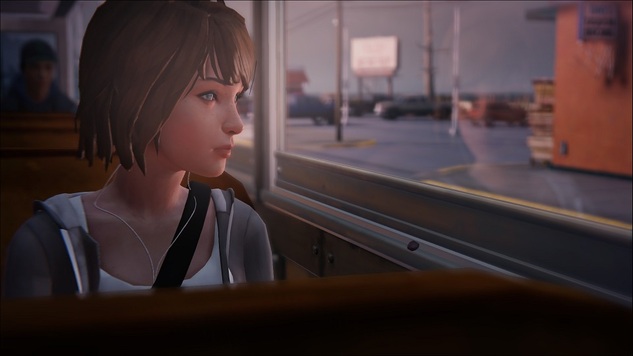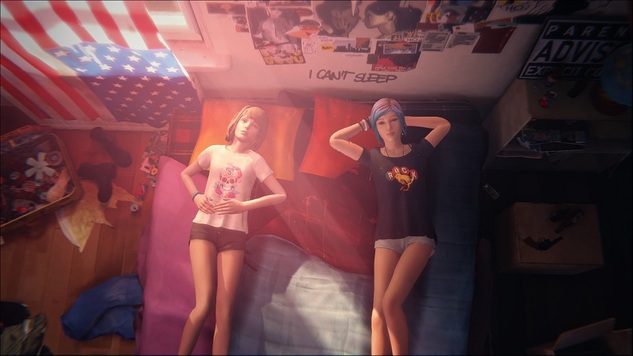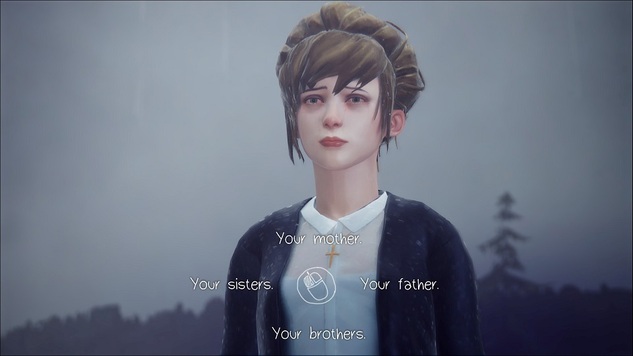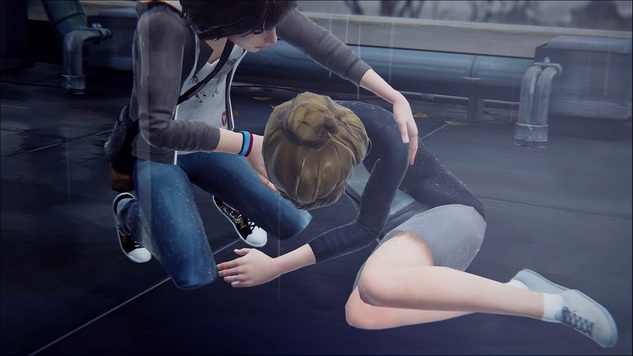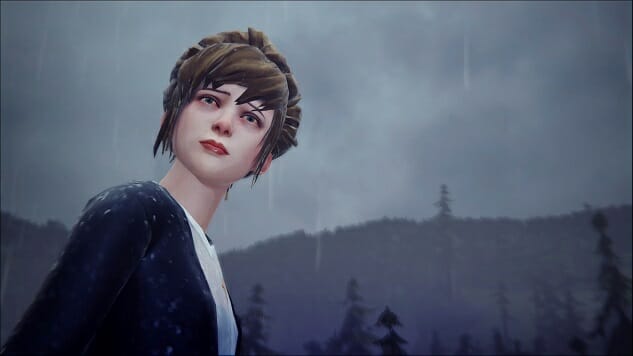
I’m so sorry, Kate. I let us down.
More than enough has been said about Life is Strange, the episodic five-part adventure first released by Square Enix early last year. It combined a unique gameplay mechanism—the heroine Max’s ability to rewind time— with the concept of the Butterfly Effect to produce a game that questioned the uncertainty of the future and, ultimately, the futility of trying to change it. With this it challenged the triple A game mainstream both by rejecting the appeasement of objectives fulfilled and by denying its audience the satisfaction of a happy ending. For many, the game is devastating. I know few people who got through Chapter 2 without crying.
Perhaps the most hypnotically tempting promise of Life is Strange is the hint of control in a world otherwise out of the player’s hands. We’ve all been in difficult situations where we wonder what could have been if we’d had the chance to go back and change one key decision. Would it have helped anything? Or, as with Max and Chloe, the tornado that threatens to destroy the town, and that ultimate choice to save them or her, would it have ended up the same way anyway?
I grew up in a fundamentalist Christian household, the type you see on Trinity Broadcasting Network and Here Come The Duggars. While we didn’t belong to the Quiverfull movement, my father was a pastor at an Evangelical, Pentecostal church and my mother, a cold, troubled woman who militaristically applied her religious philosophy to every aspect of our lives, was plagued by a driving misery punctuated by her legalistic control. My two sisters and I were subject to constant emotional and sometimes physical abuse, confined to a rigid environment where a hypercritical level of vigilance and self-reliance became the only way to survive. Sometimes I don’t know how we did. Survive, that is.
When I first met Kate during Life is Strange, I didn’t come to recognize myself in her until the end of the second chapter. It’d been many years since my parents had first kicked me out of the home at 16. While my packs of birth control were the last straw for my parents, Kate instead maintains her conservativeness even as she is miles away from home at photography prep school. Her angelic image is shattered when Kate is drugged at a party and filmed behaving in promiscuous behavior, a digital-era horror that I was thankfully spared in the ‘90s.
It’s hard not to view the past with 20/20 vision. I think abused children do it more than most folks. Sometimes the only way to escape the horror of what was is to imagine what could have been, what you might have done if you’d only known how the pain and neglect would affect you later. Even though I spent most of my time as a kid suffering from a debilitating illness and taking care of my sisters, providing care and resources my parents could or would not, I still daydream about what I should have done. Maybe I could have been stronger. Maybe I could have confronted them. Maybe I could have convinced them that we were miserable and that something needed to change. Maybe I could have gotten them to care. I wish I could go back to a time where foreknowledge of the future would have helped me the most, to change everything so it didn’t end up the way it did. There’s a part of me that still blames the child I was for not making everything right.
The first time I tried to commit suicide, I was 14 and in San Francisco on a “mission trip.” The Foursquare sect of fundamentalist Christianity places heavy emphasis on evangelical outreach to non-Christian communities, and every summer I would head down to California for a few weeks of training before being sent out to impoverished cities and neighborhoods, most of which needed a good meal far more than they needed our sermons. Despite our suspect motivations, we did help some of the people we met, building houses and providing hot food. It was the most fulfilling experience I’d had in my young life up until that point, but I was still troubled, socially awkward, and utterly alone—the first time I’d longed for death was at age 8. That mission trip ended in a desperate attempt to silence my pain once and for all with a fistful of pills I’d stolen out of a counselor’s makeup bag.
It was a desperate cry for help—maybe I meant it, maybe I didn’t. Someone found me before they could take their full effect.
While Life is Strange centers mostly on the friendship and possible romance between lead characters Max and Chloe (and Max’s attempt to save Chloe from murder at the hands of fellow student Nathan Prescott), a second story underrunning the game centers on the harassment of Max’s classmate, Kate. Throughout the first two chapters of Life is Strange, the cruelty of the gossip on Max’s campus builds as word spreads of Kate’s taped exploits, the bullies of the school viciously descending on her drugged antics with glee. They openly enjoy her suffering, even as they’re aware it was not her fault.
As Max you are given the choice on a few occasions to either support and shield Kate from the unkindness of her classmates, or let indifference take hold and inaction take place, the consequences of which may lead to her death. The game is mostly dialogue-driven, and Max uses her ability to rewind time to fix minor faux pas to get the information she needs to successfully navigate conversations with those around her. Most interactions with other characters feature several responses to choose from with each exchange, and should Max make a mistake, she can just go back a few moments in time to get the answer she needs. But as she uses her powers more and more, nosebleeds, fainting spells and severe headaches suggest that pushing it may be deadly. Right when she needs those powers the most, they fail her, at the end of Chapter 2.
Kate’s despair reaches an unbearable peak and as Max exits the school halls she hears that Kate is about to jump off the dormitory roof. Everything slows down as she rushes for the stairs. She won’t be able to correct the past this time.
The final moments on a rooftop ledge can go either way depending largely on how you responded to Kate’s harassment and whether or not you picked up on the important clues in her bedroom illustrating the strained relationship between her and her family as a result of the video. As I clicked my way through the scene, I was proud of myself for making all the right decisions and saying all the right things until I reached one key interaction: Kate and her sisters.
Child abuse is far more destructive than the surface scars would suggest. With most disasters, there are survivors, earnest human beings clinging to one another to assess and process the damage. My sisters and I didn’t have that benefit. Under the overbearing eye of God and our suffocating parents, we abused and hurt one another, tattled, sold each other out, bickered and fought so bitterly it’s amazing we didn’t kill each other. The phrase “Stockholm Syndrome” doesn’t begin to describe it. The first day of my junior year of high school, we reunited on the black pavement outside my locker, making a well-intentioned but foreign stab at solidarity following my exile from the house. It ended in a screaming match across the school grounds, students gathering to watch the spectacle as my sisters tore me to pieces for “abandoning” them. There was no family to go home to. I was truly alone.
As I made my way through the dialogue checks, Kate standing on that ledge ready to die, it all came flooding back: that beam of light that breaks through the clouds as you realize that someone does actually care, the thaw of hope that comes through the fog, coaxing you back to the other side. I was there. I remember. I survived.
But at the last second, I stumbled and failed. As I appealed to Kate’s will to live by reminding her of the times I stuck up for her and the people who love her, the screen brought up a prompt, a final stop gap between Kate and suicide.
“Kate! You can’t do this to all the people who care about you.”
“No, nobody cares about me. Nobody…”
The dialogue shifts back to Max.
C’mon Holly, you know this. You missed the clues in Kate’s room the last time you spoke but in your gut you know this. You lived this. Somehow, you know.
No, not her parents. Not her mother. Not her father. You remember this.
You were an embarrassment to them, a reflection on their failure. Don’t live, they said, behave. Do what you’re told, not what you want. Deny your instincts, deny your humanity, whatever you do, don’t let them down.
The appearance of your well-being is more important than the reality. God is always watching. He doesn’t care if you’re happy. He just cares if you’re good.
I knew, even as I did that day on the black asphalt in front of my classmates, that it was the sisters. That even with the division and deception, in the end, it was the fellow survivors who would be there. But out of idealistic hope for the enduring love of mothers, the love I wish I’d had, I clicked the wrong choice. And Kate died. I died. We died.
I am not Kate. Beyond our identical pioneer-era buffounts, we could not possibly be more different. And yet we are the same. Life is Strange allowed me to feel a lot of things I was never allowed. For all the overstimulation of my modern, technologically obsessed life, the game challenged me to enjoy the simple beauty of lying on the bed with a loved one listening to music on a quiet sunlit morning. I realize in many ways (especially with the complicated but untethered genuine female friendship between Chloe and Max) it allowed me to experience a teenagehood that was taken from me.
If your response to Kate falters and she commits suicide, the game does not let you forget it. Immediately following her death, Max appeals to the school principal to hold Kate’s abuser Nathan Prescott accountable, and the conversation is heartbreaking. I knew right away that I couldn’t talk about Kate in the past tense for the rest of the game. I would have to use my own version of Max’s rewind power—a previous save file—to go back to save her.
As painful as it was, I re-played the ending of Chapter 2. Tearing through that crowd in slow motion again, it felt like I was rushing up those stairs to save myself. This time I passed the dialogue check and now the save files for Life is Strange on my Steam profile offer two paths, a world where Kate is alive and another where she isn’t. I won’t be revisiting the one where she’s gone.
When the true ending came at the conclusion of Chapter 5, I sacrificed Chloe by rewinding time to that first day and letting her die by Nathan’s hand. I’d spent the entire game trying to keep her alive and yet in the end I had to let her go. After everything I’d done to save Kate, I could not go back on it by choosing love at her expense.
But mostly, when given a chance to change it, I couldn’t let us down again.
Holly Green is a reporter, editor, and semiprofessional photographer living in Seattle, WA. She is also the author of Fry Scores: An Unofficial Guide To Video Game Grub. You can find her work at Gameranx, Polygon, Unwinnable, and other videogame news publications.
